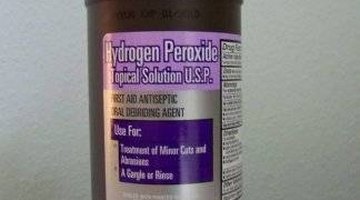How to Clean House Mold With Peroxide
Hydrogen peroxide is an effective household cleaner that can be used on a variety of surfaces and for a variety of cleaning purposes. Hydrogen peroxide can be used in place of bleach, mildew removers, floor cleaners and other cleaning agents.

Hydrogen peroxide can be used safely on clothing, floors, bathroom fixtures, kitchen appliances and other household items. Bleaches and other household cleaners can leave odors and toxic residue on surfaces. Hydrogen peroxide safely cleans without the smell, side effects or environmental damage. Hydrogen peroxide will leave your home refreshingly clean and bacteria free. This article will show you how to remove mold and mildew stains from household surfaces using hydrogen peroxide.
Things You Will Need
- Hydrogen Peroxide 3 Percent Solution
- 1 quart or smaller spray bottle
- Scrubbing Brush
- Sponge
- Latex Gloves
Tip
When cleaning moldy areas, do not touch the mold before spraying with hydrogen peroxide. Touching the moldy area will release the mold spores into the air and make it more difficult to keep mold problems manageable in the future. If an area has a significant amount of mold, wear a mask to avoid breathing in the mold spores.
Warning
Do not swallow hydrogen peroxide or get it in your eyes. If this happens, get medical help or call a Poison Control Center. The U.S. Department of Housing and Urban Development (HUD) stated in its "Healthy Homes" publication that hydrogen peroxide can be used to kill mold, but that there is not sufficient research to recommend its use. HUD is unsure which molds hydrogen peroxide is effective against or what the health hazards may be from extensive use of hydrogen peroxide.
-
Pour the hydrogen peroxide into a spray bottle. A spray bottle makes it easier to cover the moldy surface. It's a good idea to wear latex gloves while handling the hydrogen peroxide and while cleaning moldy surfaces.
-
Spot test the hydrogen peroxide before spraying on painted or colored surfaces. Hydrogen peroxide can fade colors in much the same way as bleach.
-
Spray the hydrogen peroxide on the moldy surface. Spray the surface heavily and make sure that the entire surface is saturated with the hydrogen peroxide. If you are spraying a vertical surface, such as a wall, spray from the bottom and work your way up. This way, any drips will fall on the already wet surface.
-
Let sit for 10 minutes. This allows the hydrogen peroxide to kill the mold.
-
Use a scrubbing brush to scrub away the mold and to remove the mold stains.
-
Wipe the area with a clean and damp sponge. Rinse the sponge often to keep it clean and to ensure that all of the mold and hydrogen peroxide residue are removed.
-
Store the spray bottle containing the hydrogen peroxide in a dark space. Hydrogen peroxide loses its effectiveness when exposed to light.
The Drip Cap
- Hydrogen peroxide is an effective household cleaner that can be used on a variety of surfaces and for a variety of cleaning purposes.
- Hydrogen peroxide can be used safely on clothing, floors, bathroom fixtures, kitchen appliances and other household items.
- Spray the hydrogen peroxide on the moldy surface.
- Use a scrubbing brush to scrub away the mold and to remove the mold stains.
- Rinse the sponge often to keep it clean and to ensure that all of the mold and hydrogen peroxide residue are removed.
Writer Bio
Coletta Teske has 25 years' experience writing about computers, the Internet, gardening, community theatre and Hawaiian lifestyle. Teske has freelanced for Fortune 500 companies, published more than two dozen computer books and worked as a freelance journalist. She holds a Bachelor of Science in economics from Central Washington University and is a former University of Hawaii certified Master Gardener.
Photo Credits
- Coletta Witherspoon
- Coletta Witherspoon
More Articles



